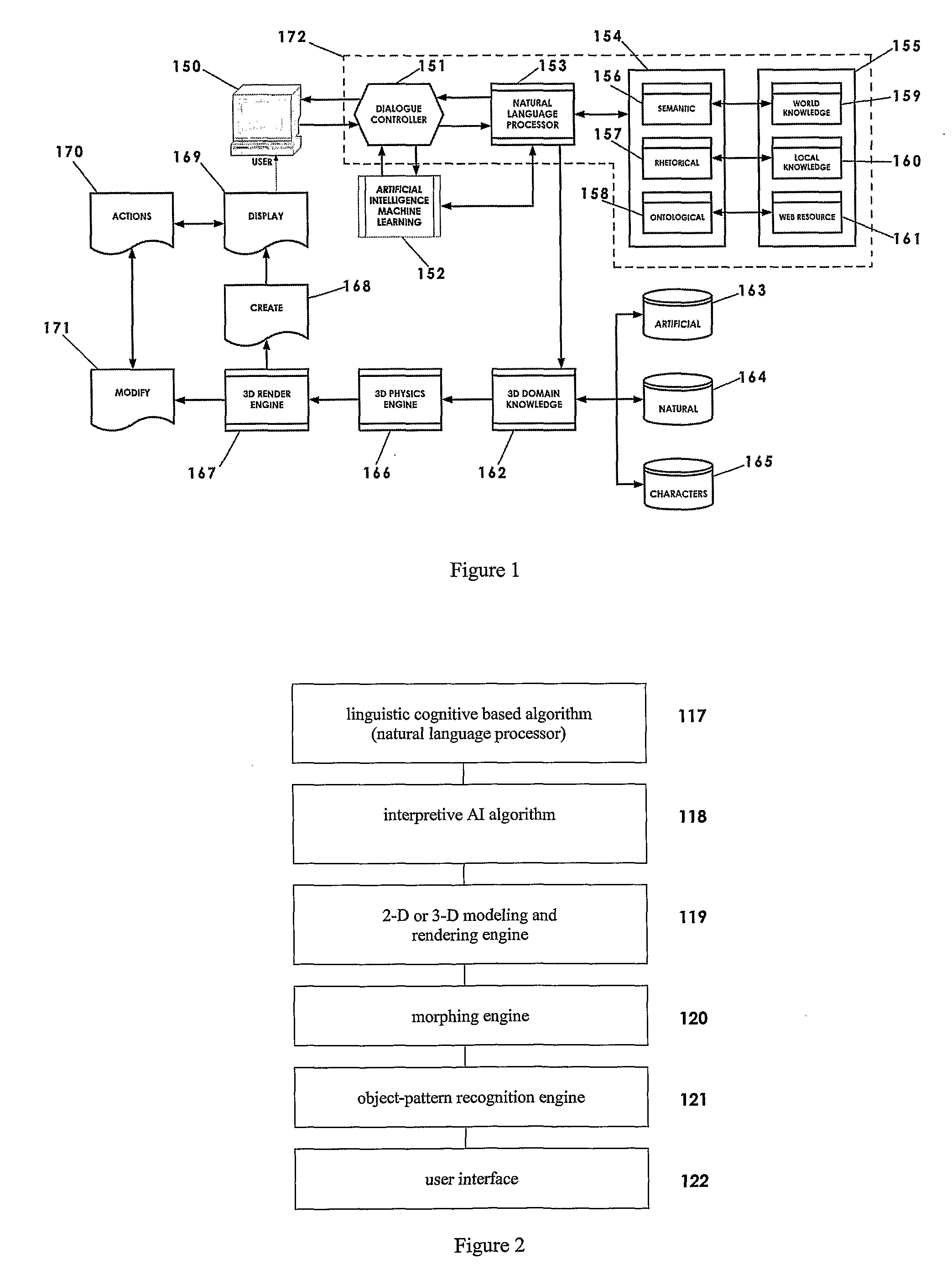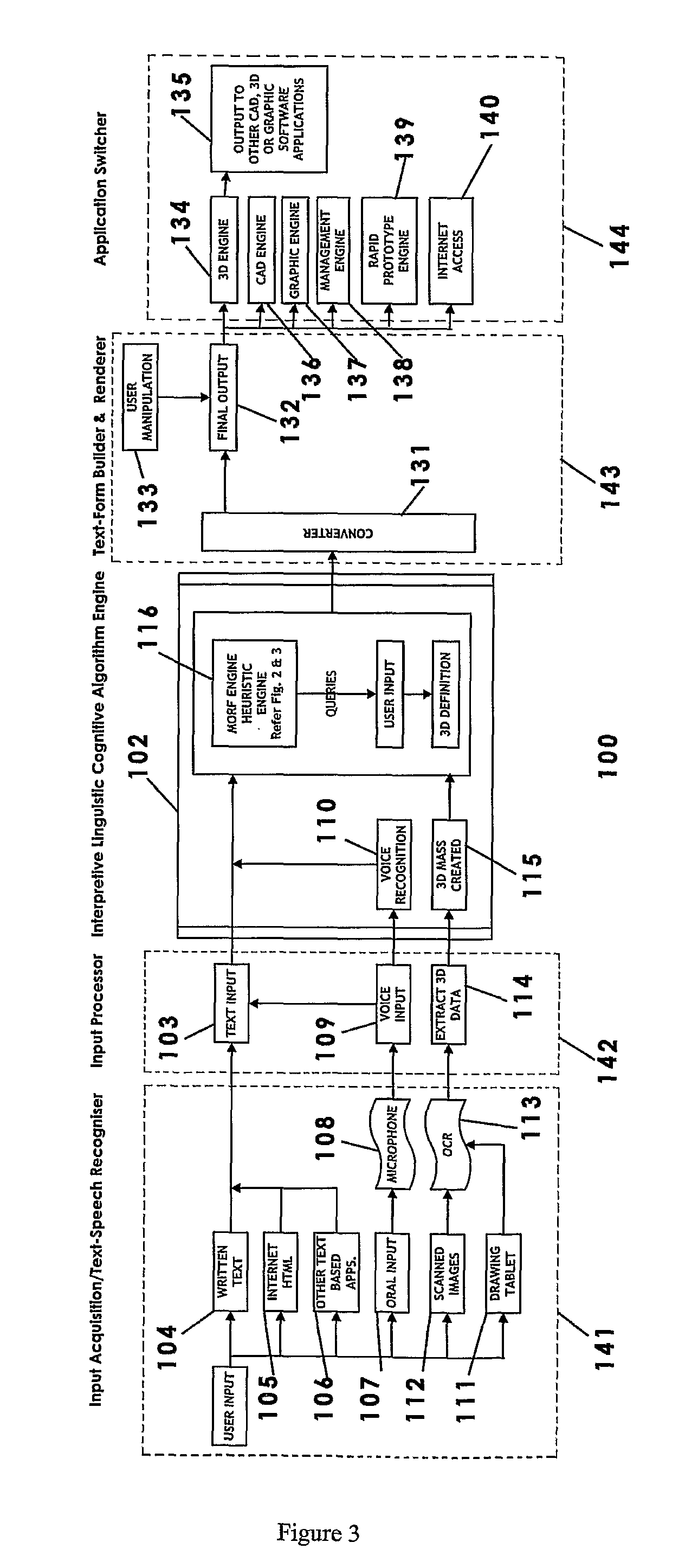Method for Transforming Language Into a Visual Form
a visual representation and language technology, applied in the field of language translation into visual representation, can solve the problems of diminishing the creative capacity of the designer, software generally suffers the same limitations as cad software, and the cad packages are unable to contribute anything to the creative aspects of the design process, so as to facilitate the understanding of the invention
- Summary
- Abstract
- Description
- Claims
- Application Information
AI Technical Summary
Benefits of technology
Problems solved by technology
Method used
Image
Examples
example 1
Modifying Representations using User or Computer Defined Tags
[0092]One means by which a visual representation may be created from text elements is by using the structural properties of the various words or text elements within the natural language that was input by a user into the computer system (102). The individual words may be analysed in some way and their meanings used to affect the visual imagery being displayed. For example names of man-made objects (table, chair), natural objects (tree, bird), characters and people (John, I, you, monster), scenery (desert, waterfall, sky), emotions (like, happy, sad), descriptions (blue, big, dry) and the like, can all be identified and used to alter the visual object's appearance. The rules for doing so can be set to provide results that intensify the creativity of the design process.
[0093]One example of how to create and alter the visual object is now described. Some input text is selected. The structural properties of the text elements w...
example 1a
Tagging According to Font Features
[0102]Text Types[0103]_-Denotes a space.[0104]1.Nouns.[0105]1.1 Nouns:[0106]One word. The first character must be an uppercase letter.[0107]Noun[0108]Thing[0109]Dog[0110]1.2 Common Nouns[0111]A noun (1.1) with ‘a’, ‘an’, ‘some’, ‘every’ or ‘my’ before it.[0112](a / an / some / every / my)_Noun; eg[0113]a Space[0114]an Apple[0115]every Individual[0116]1.3 Count Nouns[0117]A noun (1.1) that end immediately with s′ or S′; eg[0118]Places'[0119]Books'[0120]Drawings'[0121]SYDNEYS' (also a Proper noun (1.5))[0122]1.4 Mass Noun[0123]A Noun (1.1) that has ‘ / some’ in front.[0124] / some-Noun OR / someNoun; eg[0125] / some Money[0126] / some Guy[0127] / SomeThing[0128] / someThings' (also a Count noun (1.3))[0129]1.5 ProperNoun[0130]the Noun (1.1) must have all uppercase characters.[0131]NOUN; eg[0132]SYDNEY[0133]JACK[0134]1.6 Pronouns[0135]All lowercase word surrounded by curly braces { }; eg[0136]{my}[0137]{they}[0138]1.7 Reflexive pronouns[0139]A pronoun (1.6) with ‘self’ or ...
example 1b
Manipulation of Visual Form According to Text Elements Tagging
[0179]939 Nouns[0180]1.Nouns (with capital letter): agglomerate (mass created based on a number of letters and dependent on the following characteristics:[0181]BOLD: Multiplier of 2[0182]Font Size (8-72) defines height[0183]Italics: Faceted[0184]eg House, Tree, Land, Plane etc[0185]2.Common noun (a / an / some / every / my+noun): acts on noun; denotes direction and / or movement; highlights / wraps / glows with volumetrics around noun / [0186]eg a Space, an Apple, some people, everv Individual, my House[0187]3.Count noun (noun+‘s’ at the end in open inverted commas): multiples around xz axis (number of letters SQUARE—each iteration growing more transparent[0188]eg Places, Books, Drawings[0189]4.Mass Noun (‘some’+noun): glass and liquid inside semi-transparent ‘noun’[0190]eg some Things (Jimmy in this case ‘things’ would refer back to count nouns because of the ‘s’ in the word ‘things’ some networks[0191]5.Proper noun (all capitals—referr...
PUM
 Login to View More
Login to View More Abstract
Description
Claims
Application Information
 Login to View More
Login to View More - R&D
- Intellectual Property
- Life Sciences
- Materials
- Tech Scout
- Unparalleled Data Quality
- Higher Quality Content
- 60% Fewer Hallucinations
Browse by: Latest US Patents, China's latest patents, Technical Efficacy Thesaurus, Application Domain, Technology Topic, Popular Technical Reports.
© 2025 PatSnap. All rights reserved.Legal|Privacy policy|Modern Slavery Act Transparency Statement|Sitemap|About US| Contact US: help@patsnap.com



